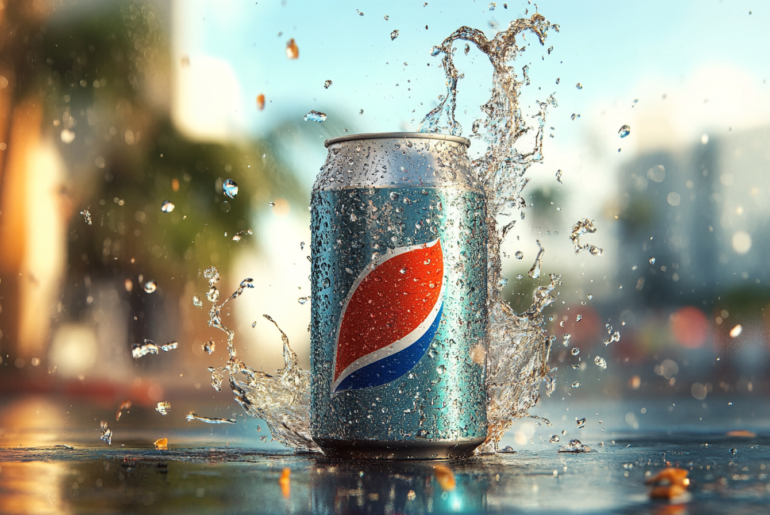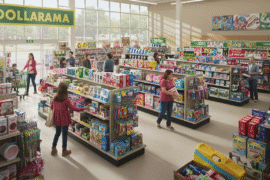This article may contain references to products or services from one or more of our advertisers or partners. We may receive compensation when you click on links to those products or services. Nonetheless, our opinions are our own.
The information presented in this article is accurate to the best of our knowledge at the time of publication. However, information is subject to change, and no guarantees are made about the continued accuracy or completeness of this content after its publication date.
- Major Highlights
- Introduction
- Understanding the Soda Wars
- The Rise of Pepsi and Its Competitors
- Major Players in the Beverage Industry
- The Battle for Market Share
- Analyzing Pepsi’s Position in the U.S. Market
- Trends Shaping the Soda Industry
- Beginner’s Guide to Analyzing Soda Market Trends
- What You’ll Need to Get Started
- Step 1: Identifying Major Players
- Step 2: Tracking Market Share Shifts
- Conclusion
- Frequently Asked Questions
- Which company currently leads the soda market in the U.S.?
- How has Pepsi’s market share changed over the past decade?
- What factors are influencing consumer preferences in the soda industry?
- Are health trends affecting soda sales for major brands like Pepsi?
- What role does advertising play in the ‘soda wars’?
- Recommended Reads
Major Highlights
- PepsiCo and Coca-Cola dominate the global soda market, constantly battling for market share leadership.
- While Coca-Cola holds the current lead, Pepsi’s diverse product range, including snacks, makes it a strong contender.
- The soda industry is evolving with shifting consumer preferences toward healthier and zero-sugar options.
- Understanding soda market trends requires analyzing market share, new product launches, and consumer preference data.
- Tools like Statista provide valuable data for those interested in the complexities of the beverage market.
Introduction
The soda market is full of bubbly sweetness, well-known brands, and strong competition. We are exploring the soft drink industry to learn about the trends shaping the ongoing “cola wars.” Companies spend hundreds of millions of dollars on marketing and advertising, using celebrity endorsements and catchy jingles to gain an edge. But who is winning? Let’s dive in and find out.
Understanding the Soda Wars
The “soda wars” refer to the intense competition between major non-alcoholic beverage brands, especially Coca-Cola and PepsiCo. This rivalry extends beyond taste, influencing customer loyalty, sales strategies, and market share. Over the years, this competition has resulted in creative marketing campaigns, memorable advertisements, and a constant stream of new product releases.
The soda industry continues to evolve as consumer preferences shift, requiring brands to adapt and innovate.
The Rise of Pepsi and Its Competitors
Pepsi was created in the late 1800s by pharmacist Caleb Bradham as a drink initially marketed for aiding digestion. The name “Pepsi” comes from the word “dyspepsia,” meaning indigestion. The beverage quickly gained popularity, sparking an ongoing rivalry with Coca-Cola.
Dr Pepper, which also emerged around the same time, further fueled competition in the soft drink market. Today, Coca-Cola, Pepsi, and Dr Pepper remain industry leaders, continuously adapting to meet global consumer demands.
Major Players in the Beverage Industry
Three major companies dominate the global beverage market: Coca-Cola, PepsiCo, and Keurig Dr Pepper. Coca-Cola, with its iconic red logo, has held the top position for years and offers a diverse product lineup, including the popular Diet Coke.
PepsiCo is a close competitor, differentiating itself with a broader portfolio that includes snacks such as Doritos and Lay’s. This diversification strengthens its market presence and provides cross-promotional opportunities. Keurig Dr Pepper, known for a variety of beverages, including Dr Pepper, rounds out the top three players in the industry.
Market share competition in the beverage industry is fierce, with even small percentage shifts leading to significant revenue changes. Coca-Cola and PepsiCo continuously monitor trends and consumer preferences, adjusting their strategies to maintain leadership and attract new customers.
Expanding into international markets, particularly in emerging economies, has intensified competition. This global contest showcases the importance of brand loyalty, strategic marketing, and market adaptability.
Voted "Best Overall Budgeting App" by Forbes and WSJ
Monarch Money helps you budget, track spending, set goals, and plan your financial future—all in one app.
Get 50% OFF your first year with code MONARCHVIP
Analyzing Pepsi’s Position in the U.S. Market
In the U.S., Coca-Cola generally holds a larger share of the carbonated soft drink market. However, PepsiCo remains a formidable competitor, leveraging its extensive product portfolio.
PepsiCo leads the snack food sector with brands like Lay’s and Cheetos, which complement its beverage offerings. This diverse product lineup allows for bundled promotions and strategic marketing efforts that influence consumer purchasing behavior.
Trends Shaping the Soda Industry
The soda industry is constantly evolving due to changing consumer preferences and market trends. One of the most notable shifts is the demand for healthier beverage alternatives. Growing concerns about sugar consumption have led to increased interest in zero-sugar sodas, flavored sparkling waters, and natural fruit juices.
| Trend | Impact on the Soda Industry |
|---|---|
| Zero Sugar | Increased demand for Diet Coke, Pepsi Zero Sugar, and other diet options. |
| Energy Drinks | Growth in market segment with brands like Red Bull and Monster competing. |
| Healthier Alternatives | Rising popularity of flavored sparkling waters, teas, and functional beverages. |
These trends have prompted major beverage companies to diversify their portfolios, ensuring they cater to health-conscious consumers while maintaining their core soft drink business.
Beginner’s Guide to Analyzing Soda Market Trends
Understanding how market forces impact the beverage industry may seem challenging at first. However, with the right tools and data, identifying key trends becomes easier.
Tracking market share changes, advertising expenditures, and new product launches provides valuable insights into which companies are successfully adapting to consumer preferences and shaping the future of the soda industry.
What You’ll Need to Get Started
To analyze soda market trends effectively, access to reliable data sources is essential. Statista is a valuable platform that provides a wealth of statistics and market data for the beverage industry.
Creating a free Statista account allows you to explore various datasets and identify relevant market insights. For deeper analysis, a premium subscription enables access to full datasets and comprehensive industry reports.
Step 1: Identifying Major Players
The first step in understanding soda market trends is identifying the dominant companies. As discussed, Coca-Cola, PepsiCo, and Keurig Dr Pepper are the key players. Analyzing their market positioning, product portfolios, and strategies provides a foundation for deeper insights.
Reviewing past market share data, brand expansions, and financial reports helps track each company’s competitive standing. Monitoring mergers and acquisitions can also indicate strategic shifts and potential market disruptions.
After identifying the major players, the next step is monitoring market share trends. Industry publications such as Beverage Digest offer valuable insights into CSD sales and consumer preferences.
Observing long-term trends reveals which brands are gaining or losing market share and the factors driving these changes. Economic conditions, shifting consumer preferences, and marketing campaigns all influence market dynamics. Analyzing free cash flow allocations—whether toward innovation, product development, or acquisitions—can provide further competitive insights.
Conclusion
The soda industry remains highly competitive, with Pepsi striving to increase its market share against key rivals. Understanding consumer preferences and market trends is crucial for maintaining a competitive edge. By analyzing industry data and consumer behavior, businesses can make informed decisions to navigate the evolving landscape of the beverage market. Staying informed, adaptable, and innovative is essential for success in the ongoing soda wars.
Frequently Asked Questions
Which company currently leads the soda market in the U.S.?
As of early 2024, Coca-Cola holds the largest market share for carbonated soft drinks (CSD) in the United States. PepsiCo remains a significant competitor but has not surpassed Coca-Cola in this category.
Over the past decade, PepsiCo has faced challenges in the CSD market, with a gradual decline in market share. Changing consumer preferences and the growing demand for healthier beverage options have contributed to this shift.
What factors are influencing consumer preferences in the soda industry?
Consumer preferences are increasingly driven by health concerns, with younger generations favoring healthier beverage options. Zero-sugar sodas, flavored sparkling waters, and natural fruit juices have gained popularity as alternatives to traditional soft drinks.
Are health trends affecting soda sales for major brands like Pepsi?
Yes, health trends have led to declining sales of traditional sodas. In response, PepsiCo has expanded its product lineup to include healthier options, such as low-calorie beverages and functional drinks.
What role does advertising play in the ‘soda wars’?
Advertising is a key battleground in the soda wars. Coca-Cola and PepsiCo invest heavily in celebrity endorsements, memorable jingles, and high-profile campaigns, such as the ‘Pepsi Challenge,’ to influence consumer preferences and brand loyalty.

Reviewed and edited by Albert Fang.
See a typo or want to suggest an edit/revision to the content? Use the contact us form to provide feedback.
At FangWallet, we value editorial integrity and open collaboration in curating quality content for readers to enjoy. Much appreciated for the assist.
Did you like our article and find it insightful? We encourage sharing the article link with family and friends to benefit as well - better yet, sharing on social media. Thank you for the support! 🍉
Article Title: Pepsi Market Share Trends: Who’s Winning the Soda Wars?
https://fangwallet.com/2025/08/08/pepsi-market-share-trends-whos-winning-the-soda-wars/The FangWallet Promise
FangWallet is an editorially independent resource - founded on breaking down challenging financial concepts for anyone to understand since 2014. While we adhere to editorial integrity, note that this post may contain references to products from our partners.
The FangWallet promise is always to have your best interest in mind and be transparent and honest about the financial picture.
Become an Insider

Subscribe to get a free daily budget planner printable to help get your money on track!
Make passive money the right way. No spam.
Editorial Disclaimer: The editorial content on this page is not provided by any of the companies mentioned. The opinions expressed here are the author's alone.
The content of this website is for informational purposes only and does not represent investment advice, or an offer or solicitation to buy or sell any security, investment, or product. Investors are encouraged to do their own due diligence, and, if necessary, consult professional advising before making any investment decisions. Investing involves a high degree of risk, and financial losses may occur including the potential loss of principal.
Source Citation References:
+ Inspo
There are no additional citations or references to note for this article at this time.












































